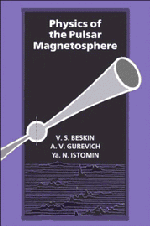Book contents
- Frontmatter
- Contents
- Introduction
- List of Notation
- Constants and Quantities
- 1 Basic observational characteristics of radio pulsars
- 2 Neutron stars
- 3 Physical processes in the pulsar magnetosphere
- 4 Electrodynamics of the pulsar magnetosphere
- 5 Generation of electron–positron plasma in the pulsar magnetosphere
- 6 Pulsar radio emission
- 7 Comparison of theory with observational data
- Conclusion
- Appendix
- References
- Additional literature
- Author index
- Subject index
Introduction
Published online by Cambridge University Press: 12 October 2009
- Frontmatter
- Contents
- Introduction
- List of Notation
- Constants and Quantities
- 1 Basic observational characteristics of radio pulsars
- 2 Neutron stars
- 3 Physical processes in the pulsar magnetosphere
- 4 Electrodynamics of the pulsar magnetosphere
- 5 Generation of electron–positron plasma in the pulsar magnetosphere
- 6 Pulsar radio emission
- 7 Comparison of theory with observational data
- Conclusion
- Appendix
- References
- Additional literature
- Author index
- Subject index
Summary
Pulsars, or more precisely radio pulsars – sources of pulsed cosmic radio emission – were discovered in 1967 and almost immediately identified with rotating neutron stars. Such stars must originate from catastrophic gravitational contraction (collapse) of ordinary stars that have exhausted the stores of their nuclear fuel. In neutron stars, the gravitational forces are brought to equilibrium not by plasma pressure, as in ordinary stars, and not by pressure of degenerate electrons, as in white dwarfs, but by pressure of strongly compressed neutron matter. They are, so to say, huge clusters of nuclear matter, and although their mass is of the order of the solar mass, their radius is only about 10 km.
An experimental discovery of pulsars, i.e. the neutron stars predicted by Baade and Zwicky as far back as 1934, is rightly regarded as one of the greatest discoveries in astrophysics. For this discovery, Hewish was awarded the Nobel Prize in 1974. There is a very large amount of literature devoted to radio pulsars – in a little more than two decades after their discovery, about 5000 papers have been published. The basic methods of study and the results of observations of radio pulsars are summarized in the excellent monographs by Manchester & Taylor, and Smith, both titled Pulsars and published in 1977, and in Pulsar Astronomy by Lyne & Smith published in 1990.
Radio pulsars are now under study in practically all of the biggest observatories of the world. In particular, the list of sources discovered is increasingly large.
- Type
- Chapter
- Information
- Physics of the Pulsar Magnetosphere , pp. xi - xivPublisher: Cambridge University PressPrint publication year: 1993



